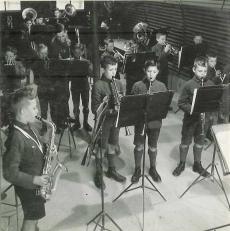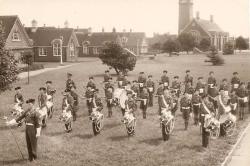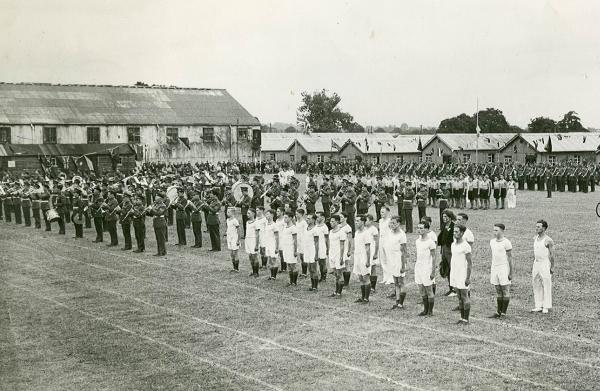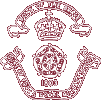In the autumn of 1963, shortly after joining the School, I stood in line with others awaiting inspec-tion by 'Bandy ' Ough (pronounced Oh!) who would, by the mystical art of assessing the shape of our mouths and teeth, decide what musical instrument we were each to learn to play. As the son of a bandmaster, my choice was already made. I would play the cornet. Bandy Ough told us to clench our teeth to check for evidence of 'overhang'. The lad next to me seemed normal enough, but Bandy declared him 'No good'. Not wanting to experience my neighbour's humiliation I blurted out 'Corps of Drums, sir!' the moment Bandy appeared to my front. Assigned to the drum corps, I dis-covered that I was expected to play the bugle and flute as well as learn the art of drumming at which, however, I was hopeless. I made decent progress on the flute however.
We practiced in the hut on the south side of the parade square, some little way distant from the main band room. The flute was soon withdrawn from service in the drum corps, so I was down to the bugle, a magnificent instrument of brass and copper when polished, but of limited musical range of five notes, no more. I reached the third note but struggled with fourth and fifth. We played a limited repertoire of bugle 'tunes' by ear under our bugle-major, a ruddy-faced Devonian, 'Waggy' Wagstaffe, a brusque but friendly man. When I made a breakthrough to the higher notes, he said, 'You could become one of the finest buglers who ever marched through these gates,' which was a surprise to me; to others too. Since then I never acquired the range or the suppleness of tonguing. Even so, I developed a good tone and sense of timing, which gained me promotion into the rear rank of the band. Promotion to the band also qualified me to wear a peaked cap, white belt, braid across my chest, a silver bugle and, best of all, a gold leaf emblem of a drum on my sleeve. This additional paraphernalia to my dress uniform required a good deal of cleaning and polishing.
Our most popular marches were Marching through Georgia and Sambre et Meuse. We also made a contribution to Seventy-six Trombones, though the most tongue-twisting musical input was to 56 Brigade. In some marches, bugles spent a lot of time 'at rest' and, most obviously, no contribution at all in exclusive band scores. In contrast, we became expert in the counter-melodies that the low-er brass instruments would play, especially the euphoniums. Much semi-covert humming went on, in Old Comrades, for example, that famous and popular march of German origin under its compelling title Alte Kameraden. Other favourites were the compositions of Kenneth J. Alford: Colonel Bogey and Great Little Army, which has a magnificent cornet obligato or decorative descant that soars gloriously above the underlying melody.
|
 |
Budding musicians of B Division at practice under CSM Jan Fry (c1944)
The Corps of Drums (1955) outfitted in blue berets in marching order |
 |
Our main duties were on the weekly Sunday church parade. There was Grand Day, of course, with its term-long rehearsals. We in the band were grateful to move by marching up and down while the companies waited at ease or attention for the inspection sequel. There were also public engagements - tattoos at Crabble, where , unusually for us, we played Sunset; and once the playing out-of-port of a German destroyer. On board, a rating beckoned me over by the taffrail to give me his loose change: a three penny Joey and some large old coppers. This surprise bonus bought a lime flavoured ice lolly.
We came into our own on Remembrance Sunday when we played the Last Post and Reveille at the school cenotaph. We were also frequently booked, solo or in pairs, to play the same function around churches in East Kent. My memories are of obscure evensongs in gloomy churches, the vicar sporting medals on his surplice, and of grey-haired spinsters mourning lost lovers. Our reward was a good tea and 2/6d (12.5 p in today's money, but more than a week's pocket money then). We retained the somewhat unnecessary bugle calls of military life. Duty buglers sounded two calls before lunc, starting with Cookhouse. Once, during a minor fire in a school hut, I was told to make the rounds in the early hours of the morning to play the all clear. That was a call not in our repetoire, so I improvised with the bugle call for reveille.
Sensibly, everyone ignored the summons and stayed in bed. Finally, there was a comic moment. For Grand day we followed a tradition of playing the pop song of the moment in a band arrangement of Congratulations, which begins with a racy bass drum intro - pam pa-pa pa-pah, pam pa-pa pa-pah, pam pah-pah-pah. In the distance, the companies on parade were unable to cope with the 'wild rhythm'. As a result the entire parade came to a juddering halt.
I mention the often paltry sums paid for playing engagements, which Gilbert of G & S fame recognized in The Gondoliers when a character expostulates on the unreasonable-ness of a band wanting to be paid. The issue of payment for musical service has permeated the experience of military bands through the ages, so a comment on Sir Arthur Sullivan's father, Thomas Sullivan, who was a boy of the old Royal Military Asylum is worth making. He was a musician of note in his day, introduced to music at the RMA. In fact, the Dukie tradition is intertwined with the history of the Royal School of Music at Kneller Hall, which is well worth examining, for there has been a constant flow of Dukie musicians to Kneller Hall and we have provided a number of outstanding professors of music to the famous institution (see Professors of Music; three and possible five of whom were RMA boys).
My own father was an Army bandmaster from 1943 to 1969, in turn for the Royal Artillery Middle East, the West Yorkshire Regiment, Yorkshire Brigade, and the Women Royal Army Corps. As a member of the School band from 1963 to 1969, I developed a lively appreciation of all types of music, not just military marches.
Field Marshal Sir Gerald Templer, former Chief of Imperial General Staff, wrote that 'All soldiers who understand regimental soldiering properly appreciate what military music contributes to military efficiency in the broadest sense. Sometimes those in positions of authority … have been tempted to see in bands a fruitful source for economy in manpower and money. Usually better judgements have prevailed before too much damage has been done.' Nevertheless, despite this optimistic outlook, all but one of the bands my father led have disappeared. I'm pleased however to note that his band played for Field Marshal Templer during the Malaya emergency of the 1950s.
Drums and bugles have been a feature of military life stretching back into antiquity, not least for their usefulness in camp and battle to communicate orders. The performance of drums and bugles was supplemented during the 16th Century, and vastly improved, by the addition of the fife - at that time known as a Swiss pipe - and, in more modern times by the b flat piccolo. I was taught to play a modern, properly keyed flute as well as the drums and bugle. In the early 1960s, the Drum Corps took turns with the full band in playing marches for the daily march of companies to lunch.
During my time, the flute was dropped from use by the Drum Corps because, I believe, the new bandmaster and bugle-major both were ex-Royal Marines in which arm of the service the Corps of Drums drummers played the bugle as well as the drum. In our case, while the flute was dropped, the functions of drummers and buglers remained separate, the drummers leading, buglers to the rear.
My father never wholly accepted that members of the Drum Corps were musicians, rather as opera orchestra instrumentalists laugh at the idea of singers being musicians! Drummers and buglers play from memory. Regular bandsmen read music cards clipped onto their instruments or arms (in the case of flautists). Originally, it is true, members of the Corps of Drums were recruited from soldiers of the line. This was to some extent true of the main military band. It is equally true that as early as 1782 civilians temporarily donned a military uniform when contracted to play in small wind ensembles for one of the three Guards regiments.
The distinction between musicians and regular soldiers is maintained in the contemporary Army. Bandsmen function as paramedics on active service while the Corps of Drums provide machine gun and fill other defensive roles to the CO's position. Major General Patrick Cordingley, who commanded a brigade in the first Iraq War 1991, was delighted to report that when a victory parade was planned the Americans regretted that their own bands had not brought their instruments. The Brits had done so without formal authority, 'just in case' and so provided music for the parade.
Bands were developed in the 17th Century from quite modest beginnings. For example, the Royal Artillery Band of 1762 had a strength of 10 musicians: pairs of trumpets, horns, bassoons and four hautboys (the louder, predecessor of the modern oboe that looked like a modern, overgrown recorder). Other bands had eight musicians based on the model fixed by Frederick, King of Prussia, for his own bands in 1763 following the end of the Seven Years War in which Prussia and Britain triumphed over France. King Frederick of Prussia was himself an accomplished flute player.
The palm leaf for development of the military band belongs to France, for in the 17th Century, Louis XIV had his court composer, Jean-Batiste Lully (1632 -1687), organise military bands and compose melodies for them centred on hautboys and drums. French love of display over a century later during the Revolutionary and Napoleonic Wars saw the formation of the more extensive military bands. [As an aside, the regimental march of my father's regiment, the 14th Foot (The West Yorkshire Regt. amalgamated today with the 15th, 19th 33rd and 76th of Foot to form The Yorkshire Regiment) was the French revolutionary song Ca Ira (loosely translated 'it will go well for us'). This was adopted on the battlefield against the French when the spirited counter-playing by the regimental band of the French tune was credited as having helped drive the enemy from the field!
A modern day authority (1970) specifies the composition of a military band as piccolo/flute, oboe, 12-14 clarinets (+ 2 bass clarinets), 2 saxophones alto and tenor, 2 bassoons, 4 horns, (2 baritones), 2 euphoniums, 4 bombardons (wonderful name - e flat basses today), 4 cornets, (2 trumpets), 3 trombones, 2 drums/percussion for a total strength of 46 musicians. I have placed in parenthesis those instruments not represented in any of the bands I knew of in the 1950s and 60s. My recollection of regiment of the line bands was closer in number to the mid 30s. Staff bands were considerably larger, but none compared with the band of the Duke of York's in the 1963-69 period, which exceeded seventy musicians. [A Dukie of an earlier era put the combined band in his day at nearer a hundred musicians, which produced a formidable sound when playing in tune and even more formidable when not!]
|
|
 |
|
|
The 75-strong band of the 7th Dragoon Guards in 1946 during the visit of Field Marshal Montgomery to the Apprentice Training School, Arborfield. Of the band complement, about 45 to 50 were ex-Dukies drafted into the Army's apprentice-training programme at age 14½ to 15. |
|
In short, the modern military band is considerably larger than its forerunner in previous centuries. This was undoubtedly due to the establishment of the Royal Military School of Music at Kneller Hall, Twickenham, in 1857, brought about by the Duke of Cambridge as part of his post-Crimean War military reforms, which neatly returns us to a massed parade of 1854 in Scutari held to celebrate the birthday of Queen Victoria. Public memory has it that Cambridge was present for the occasion and horrified when a miscellany of British bands struck up the national anthem at different pitches and in differing keys in the presence of superior French allies.
During his near 40 years (1856-1895) as C-in-C of the Army, Cambridge had a particular and abiding bugbear regarding military music. Civilian bandmasters, frequently German, were indepen-dent of military control and discipline. He offered them regular army commissions, which they declin-ed en masse. Why would they want to go to some pestilential outpost on their regiment's posting abroad when they could live high on the hog in London and in other fashionable centres of musical life? Nor were regimental officers collectively convinced commissions for civilian bandmasters were to their liking. One must here note that the creation of military bands came about in the 1760s by the subscription of each regiment's officers. This was to improve the performance on parade their men and to assure themselves of musical entertainment for the social life of the officer's mess. According to a guide published in 1782, the officers' 'private band' would allow 'lending them to private parties, assemblies etc.'
Here lies the origin of military bands undertaking public and non-military engagements. According to one Brigadier of my acquaintance, put out by his band's unwillingness to undertake mundane military obligations like guard duty, 'they are paid extra fees to do it!' I couldn't resist asking why else would an accomplished, intelligent musician serve on a private's pay in the British Army?
Military regulations control the number of musicians in a band. In 1821 a reminder was circulated that band strength should not exceed 'a Sergeant Master and 10 musicians.' In 1823 that was revised to 'and 14 musicians', and in 1846 to 'and 20'. To fund the regimental band, regimental officers paid a rate of 20 days pay on their appointment to the regiment, and 12 days annually thereafter.
No wonder that Cambridge's fulminations against civilian bandmasters came up against the notion of the officers' private band. The last notable civilian bandmaster, Cavaliere Zavertal, retired in 1906 although, it is noted, two thirds of bandmasters were military by the mid-1870s. Moreover, Cambridge insisted that candidates for civilian appointment must be tested for competence by the Military School of Music, Kneller Hall, which he had created.
To emphasise the continuing sense of ownership by the officers is a story from the early 1950s in Malaya when my father's band was required to play for a mess function. At midnight, all duties completed, the band retired to bivouac on the mess lawn. In the early hours, the CO, still carous-ing, summoned the band to rouse itself and play again. My father refused the order from the adju-tant who was instructed to put the bandmaster under close arrest if he would not comply. My father turned over on his camp bed leaving the adjutant to sit and carry out the order, but he, the bandmaster, was going back to sleep. When he awoke in the morning, the adjutant had gone and nothing more was said! Wiser, if sore heads prevailed perhaps.
Cambridge instituted the first Military Music Class in March 1857 at Kneller Hall, Twickenham, formerly the stately home built in 1709 for the court painter, Sir Godfrey Kneller. The first intake of 85 bandsmen included 17 boys. KH, as the Hall soon became known, had been in the possession of the Government since the mid 1840s. It was at one time considered as a new home of the Royal Military Asylum to make the Chelsea property available for redevelopment as a new Guards barracks. There is some evidence the authorities thought to combine the RMA and KH, possibly inspired by the record of the Asylum producing band boys for the Army as part of its effort to inculcate practical military skills.
Among these boys was Thomas Sullivan, who entered the Institution in 1814 at aged 9. He left to join the band of the Royal Military Academy, Sandhurst, in which he served for 14 years. He returned as Sergeant Master in 1849, on 3/- a day (15p). Regimental sergeant masters received regimental pay and up to £100 annually from the regimental band fund, presumably not available at Sandhurst. Sullivan's salary was £115 a year when he was appointed tutor to reach the clarinet, 'the larger brass instruments' including the bombardon, and to demonstrate the violin to anyone interested.
Cambridge standardised military instrumental pitch to that 'lately practised at the Ancient Phi-lharmonic concerts' and had a tuning fork issued to each regiment (to be kept under lock and key!). One speculates that he remembered the cacophony at Scutari a few years earlier? He was not fully successful in creating an agency at KH for the central purchase of musical instruments to standar-dise them throughout the Army. He also intended cutting out the practice of bandmasters (espec-ially civilian bandmasters) making a commission on the instruments bought. He must have been aware that civilians were often appointed from lists held by instrument-making companies, who naturally expected them to buy only instruments from the company whose list from which they had been selected.
The Military Music Course was paid for by Regimental COs - £5 down per musician and £8 yearly. Since the transfer of a small unit of 85 men had otherwise cost next to nothing at KH, one may sur-mise that the estimate of £33,000 to fit out KH to receive the RMA was the main reason the amal-gamation never happened. The aims of the MMC were understood only in a confused fashion at regimental level. Cambridge wanted up to two musicians per regiment to attend of which one might be a boy if desired. Some regiments misunderstood this to be basic music training, whereas KH was aiming to select the most promising bandsmen and boys for superior training. One third would be for the new class of prospective sergeant bandmasters Cambridge had in mind, studying for two years, two thirds as advanced instrumentalists who would return to their regiments, and as NCO material after 18 months study.
The position of band boys deserves further comment. In the 1880s, the Horse Guards issued an order with respect of boys from the Duke of York's and Royal Hibernian Military School hat they complete six months tuition at KH upon leaving school and before joining their regiments, rather than the reverse practice.
The tuition and training at the Royal Military School of Music. Kneller Hall, is the same today as it was in the institution's early years. Only in Queen Victoria's last years were sergeant bandmasters promoted to the rank of WO1, and a handful of the top regiments' bandmasters - the Guards and the Royal Artillery - were given the commissioned rank of Lieutenant. Later some bandmasters rose to the rank of Lt.-Col while later still the title Director of Music was introduced. Today, in order to advance to a commission and that loftier title of D o M, bandmasters must undertake postgraduate study and be examined to earn a PSM (Passed School of Music). External examination has been included at KH since the 1890s and the standard of the course exemplified by the fact that, for example, my father passed out a Licentiate of the Royal Academy of Music at which, incidentally, Thomas's son, Sir Arthur Sullivan was the first Mendelssohn scholar and an Associate of the Royal College of Music (which Sir Arthur helped found). These two institutions are today are the senior conservatoires of music in Great Britain.
The career of Lt.-Col. Rodney Bashford OBE best illustrates the career trajectory of a talented military musician in the 20th century. Bashford, a Dukie, joined the Army as a junior bandsman at age 17. He remembered the 1930s as the halcyon days of military bands, many exceeding 70 in strength. He was a student bandmaster at KH immediately after WW2 and by 1960 was Director of Music of the Grenadier Guards (-1970). He then served as Director of Music at KH, and in 1993 was still active as curator of its museum well into his 70s.
The outstanding tradition of military music in Great Britain continues to this day. But cutbacks and amalgamation have taken their toll. From the 135 or so bands the Duke of Cambridge oversaw in the second half of the 19th Century there are today fewer than 30. Territorial bands of reservists are in many cases taking on public ceremonial engagements. Yet it may still be said, as voiced by Field Marshal Templer more than 50 years ago, that we are 'not likely to forget the value of a band marching and playing through the streets.'
|
|
|
|
 |
|
 |
|
|
|
|
 |
|
 |
|





